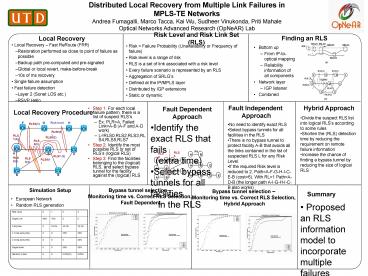Local Recovery In Multiple Link Failures
1 / 1
Title:
Local Recovery In Multiple Link Failures
Description:
RLS is a set of link associated ... Proposed an RLS information model to incorporate ... Simulation Setup. Bypass tunnel selection. Monitoring time vs. ... –
Number of Views:73
Avg rating:3.0/5.0
Title: Local Recovery In Multiple Link Failures
1
Distributed Local Recovery from Multiple Link
Failures in MPLS-TE Networks Andrea Fumagalli,
Marco Tacca, Kai Wu, Sudheer Vinukonda, Priti
Mahale Optical Networks Advanced Research
(OpNeAR) Lab
Finding an RLS
Local Recovery
Risk Level and Risk Link Set (RLS)
- Local Recovery Fast ReRoute (FRR)
- Restoration performed as close to point of
failure as possible - Backup path pre-computed and pre-signaled
- Global or local revert, make-before-break
- 10s of ms recovery
- Single failure assumption
- Fast failure detection
- Layer 2 (Sonet LOS etc.)
- RSVP Hello
- Risk Failure Probability (Unavailability or
Frequency of failure) - Risk level is a range of risk
- RLS is a set of link associated with a risk level
- Every failure scenario is represented by an RLS
- Aggregation of SRLGs
- Defined at the IP/MPLS layer
- Distributed by IGP extensions
- Static or dynamic
- Bottom up
- From IP-to-optical mapping
- Reliability information of all components
- Network layer
- IGP listener
- Combined
Fault Independent Approach
Hybrid Approach
Fault Dependent Approach
- Step 1 For each local failure pattern, there is
a list of suspect RLSs - Ex PLRA, Failed LinkA-B (A-F and A-D work)
- LRLS0,RLS2,RLS3,RLS4,RLS5,RLS7
- Step 2 Identify the most possible RLS or set of
RLSs (logical RLS) - Step 3 Find the facilities belonging to the
(logical) RLS, and select bypass tunnel for the
facility against the (logical) RLS
Local Recovery Procedure
- Divide the suspect RLS list into logical RLSs
according to some rules - Shorten the (RLS) detection time by reducing the
requirement on remote failure information - Increase the chance of finding a bypass tunnel by
reducing the size of logical RLS
- Identify the exact RLS that fails
- (extra time)
- Select bypass tunnels for all facilities
- in the RLS
- No need to identify exact RLS
- Select bypass tunnels for all facilities in the
RLS - There is no bypass tunnel to protect facility A-B
that avoids all the links contained in the list
of suspected RLS L for any Risk Level. - If the required Risk level is reduced to 2,
PathA-F-G-H-I-C-E-B (cost6). With RL1
PathA-D-B (the longer path A-I-G-H-I-C-B also
works)
Simulation Setup
Bypass tunnel selection Monitoring time vs.
Correct RLS Selection, Fault Dependent
Bypass tunnel selection Monitoring time vs.
Correct RLS Selection, Hybrid Approach
Summary
- European Network
- Random RLS generation
- Proposed an RLS information model to incorporate
multiple failures - Extended FRR to support fast local recovery
against multiple failures - Investigated three approaches, fault dependent,
fault independent and hybrid - Traded recovery time with recovery ratio































